| |||||||
| Anthem | "Farewell of Slavianka" | ||||||
| Capital | New Archangel | ||||||
| Largest city | Ross | ||||||
| Other cities | Baranovsk, New Westminster, Nushagak, Shasta, Spokane | ||||||
| Language official |
Russian (de facto) | ||||||
| others | Aleut, Chinese, English, German, Spanish, Ukrainian | ||||||
| Religion main |
Eastern Orthodoxy and Protestantism | ||||||
| others | Animism, Catholicism, Mormonism, Islam | ||||||
| Demonym | Alaskan | ||||||
| Government | Full-presidential federal republic | ||||||
| Legislature | Congress | ||||||
| President | Alexander Atamanenko (P) | ||||||
| Vice President | Boris Schweitzer (P) | ||||||
| Area | 3,836,094 km² | ||||||
| Population | 39,874,046 | ||||||
| Established | September 26, 1929 | ||||||
| Currency | Chervonets (File:Chervonets (Russian America).svg) (AKC)
| ||||||
| Time Zone | Official time zones (UTC-7 to -12) | ||||||
| summer | (UTC-6 to -11) | ||||||
| Internet TLD | .ak, .адфр | ||||||
| Organizations | NAFTA, NAM, RLU, UN | ||||||
Alaska (Russian: Аляска, Alyaska), officially the Alaskan Democratic Federative Republic (Аляскинская Демократическая Федеративная Республика, Alyaskinskaya Demokraticheskaya Federativnaya Respublika) and abbreviated as the A.D.F.R. (А.Д.Ф.Р.), is a sovereign nation which occupies the Pacific Northwestern half of North America. Alaska borders Borealia and the United States to the east, Mexico to the south, and a maritime border with the Russian Federation to the west. The ADFR is the only nation (outside the former Soviet Union) to have a large Russophonic population.
Etymology
The name Alaska (Russian: Аляска, Alyaska) is derived from the Aleut word alaxsxaq which literally translates as "the object towards which the action of the sea is directed" (or commonly simplified to "the mainland"). The name was first used by the Russians to refer to the peninsula which bears the same name, though the name was colloquially used by the Russians to describe all of Russian America. The first official usage of the name came in the 1840s with the establishment of the Alaska Oblast (the predecessor of modern day Shelikof). Outside Russia, the archaic name Alyeska was also used (which was derived from the same root word in Aleut).
The official labeling of the whole of Russian America as Alaska came in 1917 with the establishment of the Alaskan Republic (which collapsed several years later). The name was reused for the Alaskan Socialist Republic (which historically controlled the territory of the Alaska Oblast). Upon the unification of the southernmost regions of Russian America, the name Alaskan Democratic Federative Republic was officially adopted. The choice of this name was attributed to have a distinction from the Communist ASR and as an homage to the short-lived Russian Democratic Federative Republic (which was a proposed attempt to reform the Russian Empire as a democratic federation). Alaska is unique in its use of the word democratic in its official name, as most nations to have adopted the word tended to be communist states.
History
- Main articles: Timeline and History of Alaska
Russian colonialism

Early settlements of Russian America.
By the early 1800s, Alexander Baranov became head to the Russian-American Company (which held a monopoly on the fur trade held by Russia in North America). Following the Russian victories over the native peoples (the most noted was the Siege of New Archangel against the Tlingit people), Russia had secured their place in the Pacific Northwest. Cooperation with the Americans, the British, and the Spanish furthered Russian activity towards the south.
Around 1806, Russia began seeking further expansion in North America, with Spanish controlled California being the ultimate prize. Upon his return to New Archangel, Captain Nikolai Rezanov would encourage Baranov and Tsar Alexander I to establish a Russian port to the north of San Francisco (where a Spanish presence didn't exist). By 1810, Baranov would charter Ivan Kuskov to explore northern California for locations of a Russian colony. An area around Rumyantzev Bay (known as Bodega Bay by the Spanish) was selected, with Kuskov returning with furs to seal the deal. After several failed attempts to find a suitable location, a fort was finally constructed by 1812, in a territory known by the native Kashaya Pomo people as Mad shui nui or Metini.
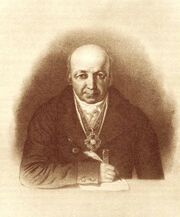
Alexander Baranov was a key leader if Russia's expansion into North America.
A colonial presence was soon established around the newly constructed Fort Ross and on the banks of the Slavianka River. Moves by Baranov and Kuskov helped to encourage further settlement in the region. While most were fur traders, members of the Russian-American Company, and their families; many Russians from the agricultural regions (including criminals and exiles) helped to increase the Russian population. The growing Russian presence brought tensions with Spain, who also claimed the territory. Russia justified their colony on the grounds that they were well north of Spain's northernmost port (San Francisco) and that no other European presence had existed prior to the Russians. Tensions with the Americans and the British were also beginning; but continued pressures from within and without would eventually push Spain into war with Russia.
Eastward expansion
By the early 1820s, the growth of Russians in North America pushed an incentive within the Russian Empire to legitimize their claims, culminating in the Ukase of 1821 — expanding Russia's claims to include all of the Pacific coast north of the 51st parallel and the territory irrigated by the Slavianka River. While the Americans and the British were opposed to the decree, the Spanish were finally pressured into war.
Hoping to remove the Russians out of California, Spain sent a modest fleet to the region to pressure the colonists to surrender and leave. Arriving in 1822, the element of surprise was ruined when Aleut fishermen spotted the ships approaching and alerted the colonists. In what would become the Battle of Ross, Russian artillery prevented a landing by the Spanish (though at the cost of Russian soldiers and colonists), followed by a short naval battle in which the colony forced a Spanish retreat. Once word reached Saint Petersburg about the failed Spanish attack, Russia declared war on Spain.
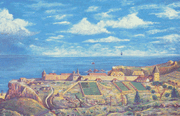
An artist's depiction of Fort Ross (circa 1828).
The Russo-Spanish War would continue for another three years, and mostly centered around the Pacific Northwest. The war turned in favor of the Russians by early 1824 when an alliance was formed between Russian and the revolutionary forces in New Spain. The war officially ended in 1825 under a Russian victory. Under the conditions of the Treaty of Saint Petersburg, Spain ceded all its claims in the Pacific Northwest to Russia, and elevated Russia into a dominant player in North America. Subsequent treaties with Mexico (1826), the United States (1826), and the United Kingdom (1827) helped lead to the present day border.
The period between the late 1820s up until the late 1840s was mostly uneventful in regards to conflict (despite growing tensions among American and British settlers). Among the more noted reasons for tensions was Russia's decision to populate the territory south of the Columbia River with exiles and other undesirable of questionable incarceration (effectively making the region a penal colony). Following American-lead tensions in Texas (1835) and Canada (1837), the Russian Empire began to reorganized their territories in North America. The Russian-American Company loses their role as the governing body of Russian America, and the territory itself was divided into three oblasts — Alaska (centered in Pavlovskaia), New Russia (centered in New Archangel), and Oregon (initially centered in Ross) — all of which incorporated into the larger American Krai. Unlike the other European colonial powers, these new oblasts were considered no different from those in Eurasia (meaning they were a direct part of the vast Russian Empire).
Golden era
The discovery of gold in 1848 effectively changed the region as people from around the world rushed to the region to get rich. The influx of people into Russia's territory pushed for the establishment of the Sonoma Oblast in 1850, transforming Ross into a major port on the Pacific coast. Other settlements would arise in the south, including Baranovsk, Kuskovsk, and Shasta.
The influx of people further helped to construct infrastructure in the area, including projects to further connect the territory to Russia. One of the most noted projects was the Russian-American Telegraph line, which was also proposed as an alternative to a Transatlantic cable (which up to this point was not being successful). Construction on the joint Russian-American-British project began in 1865, with the project being a symbolic failure after the announcement of a successful transatlantic line in 1867. Despite the setbacks, the project continued as an Imperial connection, with the project being completed in 1872. Prior to its completion, continued monetary problems lead to the purchase of British-controlled Columbia in 1871, leaving the entire Pacific Northwest under Russian control.
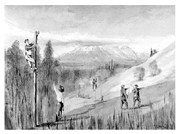
Construction of the Russian-American Telegraph.
Additional projects was the construction of the first transcontinental railroad in the 1880s, and railway system connection Ross and the northernmost settlements for the first time. The new inter-connectivity helped further populate the north (as access to raw materials was easier for stable living). Minor fishing and fur trading settlements like New Gelsingfors, Nushagak, Slavorossiysk, and Saint Nicholas could industrialize themselves and sell their products more quickly with the southern settlements and across into Mexico and the United States (and thereby the world).
The population and economy of the north would grow further after several gold discoveries across the Yukon River in the late 1890s and early 1900s. Once again, a rush of prospectors and other hoping to make it rich inundate the once rural and lowly populated regions in the north. The use of railways helped to keep the regions active, but most regions relied on sled dogs to keep connection between the gold regions and the railway hubs further south, and thereby helping to establish the dog sledding as an Alaskan heritage and symbol.
Independence
By the end of the 19th century, an "Alaskan" identity had already been developed by the residents of Russian America. This stemming from the closer connections with Mexico and the United States than with the core of Russia, combined with a diverse population boom thanks to industrialization and gold discoveries. By 1900, many characteristics were beginning to differentiate Russian America from the rest of the empire, but the most noted reason was the lack of a physical connection with Saint Petersburg (aside from ocean crossings).
In 1904, tensions between Japan and Russia would lead to war. While Russian Americans had participated in all Russian wars, the Russo-Japanese War was the first conflict in which Alaskans were a major participant and were at risk against a foreign power. Alaskans mostly fought in naval battles, but several fought in Korea and Manchuria. The combined might lead to a Russian victory in 1906. In many aspects, the Russian victory and secured access to an ice-free port on the Pacific delayed any independence movement in Russian America, but did little to stop it.
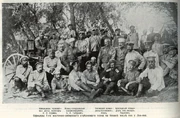
A 1904 photograph of Alaskan troops in Manchuria.
Beginning in 1907, a political movement known as Nasha Amerika ("Our America" in Russian) advocated the independence of Russian America. Among the population, a good majority began to support some form of independence, but stopped when it came to divorcing the Russian Empire. Many leaders in the independence movement favored some sort of dominion status within Russia (comparable to what Acadia, Australia, New Zealand, and South Africa had within the British Empire). Despite the growing support, Saint Petersburg and Tsar Nicholas II were not interested. Unlike the British Empire, Russia was still an absolute monarchy with vast stretches of territory, and allowing independence to one territory may lead to conflict in others (most notably the Caucasus, Finland, and Poland). It was because of this that more radical elements (centered in the more populous south) proposed all out revolution from Russia, looking towards its neighbors to help out.
The outbreak of World War I put a stop to the independence movement for the time being, with Alaskan troops volunteering to fight for Russia in the Eastern Front. The war showed the growing weakness of the Russian Empire, combined with the success of the Central Powers was enough to push dissidents in both Eurasia and America. In 1917, revolution finally breaks out in Russia, leading to the rise of Vladimir Lenin. Seeing an opportunity, the ruling bodies of the American Krai declared independence as the Alaskan Republic in late 1917. Despite gaining support by the people, the Alaskan Republic would be short-lived as the Russian Civil War spread into North America.
Civil War
- Main article: Alaskan Wars
Despite some opposition to independence and the initial rise of monarchist sentiment across Russian America, the formation of the Alaskan Republic was initially supported by the people. Despite this, opposition quickly began to rise as the new government proved to be no different from the ruling oligarchy of the Russian Empire (the only difference being no Tsar). With most of the opposition being centered in the more populous south, these regions declared independence in 1919 as the Republic of Oregon, leading to the subsequent Alaskan Wars that would last until the 1940s.

A painting of the fighting along the Kenai Peninsula in 1924.
While uniting for democracy, the many differences and allegiances across Oregon lead to infighting. The most noted violent was the move to re-establish an English-dominated government across the formerly British territories. In Victoria, the Republic of New Albion was declared, incorporating the English-dominated regions of Russian America. While having major support in the Queen Charlotte Islands and Vancouver Island, much of the mainland claims have been Russified and were divided on what New Albion should be. New Albion secured independence in 1921, and would later go to war with the northern regions to claim what would become New Caledonia. Oregon would be shrunk down further when Sonoma declared independence over growing centralization in Oregon.
In the northern regions of the Alaskan Republic, tensions would remain limited until the 1920s when pro-Soviet workers' strikes take place across Russian America (most notably in New Archangel, Nushagak, and Saint Nicholas). The more conservative and anti-Communist cities along the Gulf of Alaska violently crushed out the strikes. The settlements along the Bering Sea were more sympathetic and quickly rose into a force and government in the region. In 1923, the Nushagak Soviet declares the Alaskan Socialist Republic. Some of the worst fighting during this period were fought between the new Communist government and the anti-Communist forces which dominate the traditional core. Forcing Communist forces out of the Gulf region, the conservative territories re-establish the regions as the Democratic Republic of New Russia, which in many cases emanated the several anti-Communist government in Europe to the point of becoming a quasi-fascist state.

Mikhail Luchkovich, the first president of the ADFR.
The Alaskan Wars generally fell into a period of peace between the mid-1920s until the late-1930s when the conservative government of New Russia was removed after the assassination of several government figures. A democratic government soon rose to be led by former opposition leader Mikhail Luchkovich. Under his leadership, Luchkovich helped establish a ceasefire with Communist Alaska and to promote democracy in New Russia. The most noted accomplishment of the Luchkovich government was the reunification of Russian America, which began in 1929 with the establishment of a democratic alliance between New Russia and Oregon. While initially nothing more than an alliance, the Great Depression became a catalyst towards the full reunification in 1935. The Alaskan Democratic Federative Republic was finalized in 1931 with the adoption of a new constitution. Luchkovich was unanimously elected as the nation's first president. Under his administration, Alaska would expand to include New Albion (1934) and his home governorate of Sonoma (1935).
Despite hopes to include the ASR, Luchkovich was opposed to continued war and supported peaceful means to do this. War seemed inevitable in 1938 when rival Waino Hendrickson succeeded Luchkovich as President. Hendrickson supported any means to eliminate Communism in North America, which ended with the Siege of Nushagak in 1939. The Communist government collapsed the same year, with an exile government gaining security in the Komandorski Islands off the coast of the Soviet Union. With those islands as the exception, all of Russian America was now reunited as a single nation and Hendrickson proclaimed that Alaska was "Now at Peace."
Government and politics
According to the constitution of the Alaskan Democratic Federative Republic, the nation is a federation and a presidential republic where the president acts as both head of state and head of government. Alaska is currently structured as a two-party representative democracy (dominated by the Evergreen Party and the Peace Party), with the federal government divided between three branches (the executive branch, the legislative branch, and the judicial branch).
President
- Main article: President of Alaska

Incumbent President Alexander Atamanenko.
The President of Alaska acts as both the head of state, the head of government, and the commander-in-chief. The president is elected by the use of an electoral college (who in turn are democratically elected by the citizens of Alaska), making Alaska one of the few nations to retain the practice for electing their leader. The president is elected to serve a six-year term in office and is constitutionally barred from serving the office more than once. The current president of Alaska is Alexander Atamanenko, who has been serving the office since December 2009.
Political subdivisions
- Main article: Governorates of Alaska and New Archangel

Governorates of Alaska.
The Alaskan Democratic Federative Republic is a federation made up of 18 governorates (Russian: губернии, gubernii; singular: губерния, guberniya) and one federal district (федеральный округ, federalny okrug). Under the constitution, each governorate is a sovereign state who retain control over their internal affairs, but all united in many aspects (comparable to the United States). Initially established with the unification of two independent nations (at the time), several of these early governorates split apart into the modern day 18 (with the Far North being the most recent to gain "governoratehood" in 1994).
Demographics
| # | City | Flag | Gub. | Pop. (2007) |
|---|---|---|---|---|
| 1 | Ross | SO | 2,714,856 | |
| 2 | New Westminster | CO | 2,160,821 | |
| 3 | Baranovsk | File:Oregonian New Flag Contest Winner.svg | OR | 1,382,951 |
| 4 | Nushagak | SE | 982,765 | |
| 5 | Spokane | ID | 809,798 | |
| 6 | Shasta | SO | 701,475 | |
| 7 | Prince George | NC | 599,199 | |
| 8 | Saint Nicholas | KE | 464,310 | |
| 9 | Telegrafsk | SK | 443,775 | |
| 10 | Kamloops | CO | 345,610 | |
| 11 | Tacoma | CO | 318,172 | |
| 12 | Shoshone | File:Oregonian New Flag Contest Winner.svg | OR | 306,211 |
| 13 | New Archangel | File:Flag of New Russia (Russian America).svg | FO | 298,610 |
| 14 | Vasiliysk | KE | 265,404 | |
| 15 | Kuskovsk | SO | 254,441 | |
| 16 | Missoula | ID | 212,038 | |
| 17 | New Gelsingfors | NC | 210,309 | |
| 18 | Beloloshadsk | YK | 198,449 | |
| 19 | Vladikaskady | File:Oregonian New Flag Contest Winner.svg | OR | 157,986 |
| 20 | Furugelmsk | File:Flag of New Irkutsk (Russian America).svg | NI | 118,974 |
Population
According to the 2007 census, Alaska has a population of 39,874,046 people, but recent estimates place the population over 40 million as of 2013. This places Alaska's population within the top 30 most populous nations (roughly similar in population to Argentina). The majority of the population is centered in the southernmost governorates of Alaska. Much of the population is centered in large cities.
Ethnography
Much like the other nations of the western hemisphere, Alaska is a melting pot of many peoples from around the world. But given its connections with the Russian Empire, Alaska is dominated by Slavs and Eastern Europeans in general. The largest ancestral groups are the East Slavs — Belarusians, Russians, Ukrainians, and all variations of which (such as Cossacks and Ruthenians) — most of which came during Russian colonialism and throughout the Russian Revolution and the Cold War.
During the period of British control, the New Albion governorates saw immigration from the British Isles (mostly English and Scots) and the United States). But due to its distance and growing competition from the Russians, the population in the area remained slow. After the Columbia Purchase, much of these settlers left the region (most settling in Australia, Borealia, New Zealand, and the USA) and those that remained gradually became Russified. Today, Charlotte and Vancouver retain an "Anglo-American" majority population (with English still being spoken and understood by the population) while Columbia has an "Anglo-American" plurality (dominant) population that has been Russified (meaning the Russian language is dominant and English is mostly cultural and not widespread).

A group of Russian Alaskan dancers in traditional dress.
Other groups who immigrated to the region included non-Russian subjects of the Russian Empire. These include Armenians, Estonians, Finns (including Karelians), Georgians, Latvians, Lithuanians, Moldavians, and Poles. Because of Alaska's practice of the Orthodox Church (the only majority nation in the New World), many non-Russians immigrated: including Bulgarians, Ethiopians, Greeks, Macedonians, Montenegrin, Romanians, Serbs. Other Europeans to have immigrated to Alaska include Scandinavians (mostly Danes, Norwegians, and Swedes), Germans (mostly those from the Baltics and the Volga), and Jews.
During the mid 19th and throughout the 20th centuries, non-Europeans began to immigrate to Alaska. The most noted include those of African descent (mostly freed slaves from the Caribbean and the United States and those immigrating from the continent [including Ethiopians]). During the Gold Rushes, many from China immigrated, mostly including Han Chinese and later Manchus. Other East Asians include the Japanese and Koreans (Koreans especially after the annexation of the peninsula by Japan).
Despite the growth of non-native populations, the many first peoples of Alaska retain say across the country. The largest native groups are dominated by the Aleuts and the Inuits of northern Alaska.
Religion
According to the constitution, Alaska is a secular state which promotes the separation of church and state and secures the rights and securities of all religious practices within the nation. Demographically, Alaska is a Christian majority nation, with all major sects being practiced. The largest denomination is Eastern Orthodoxy, with Alaska being the only Orthodox nation outside the Old World. The Orthodox Church in North America dates back to the 18th century when the Russian Empire began to expand into the area.
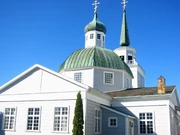
Saint Micheal's Cathedral in New Archangel is one of the oldest churches in Alaska.
The second largest Christian denomination is Protestantism, which holds dominance in the central governorates of Alaska. The British were the first to bring the church to the Pacific Northwest, and emigration from the Russian Empire and elsewhere helped make it a stable in the region. While all Protestant churches have say all across Alaska, Lutheranism has the most followers in Alaska, followed by Baptism (especially Evangelical Baptism), Anglicanism (known as the Episcopal Church in Alaska), and Methodism.
While not as extensive as in Alaska's neighbors, the Catholicism has a growing following in the nation (mostly in southern Alaska). The Catholic Church is divided between Roman Catholicism (which is the largest denomination) and Greek Catholicism (which has similarities to Eastern Orthodoxy). Other denominations of Christianity in Alaska include many Spiritual Christianity followers (most notably the Doukhobors) and the Church of Jesus Christ of Latter-day Saints (Mormons).
Judaism is the largest non-Christian religious body in Alaska, with the majority emigrating from Eastern Europe after World War II. Other non-Christian practices include Islam, Buddhism, Taoism, Hinduism, and much more. While having mostly been converted to Orthodoxy under the Russian Empire, many Native-Alaskan religions have been seeing a renaissance in recent decades, with Animism becoming the largest. According to the 2007 Census, about 15% of the population describe themselves as either being irreligious, agnostic, and/or atheist.
Template:RA-Alaska


